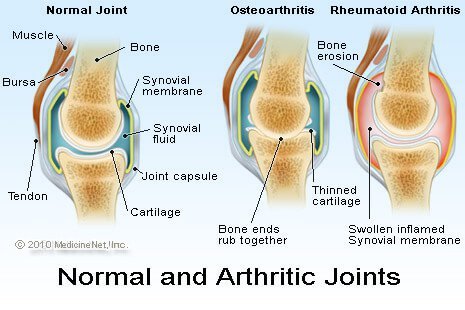What is rheumatoid arthritis (RA)?
Rheumatoid arthritis definition
Rheumatoid arthritis (RA) is an autoimmune disease that causes chronic inflammation of the joints. Autoimmune diseases are illnesses that occur when the body's tissues are mistakenly attacked by their own immune system. The immune system contains a complex organization of cells and antibodies designed normally to "seek and destroy" invaders of the body, particularly infections. Patients with autoimmune diseases have antibodies and immune cells in their blood that target their own body tissues, where they can be associated with inflammation. While inflammation of the tissue around the joints and inflammatory arthritis are characteristic features of rheumatoid arthritis, the disease can also cause inflammation and injury in other organs in the body. Because it can affect multiple other organs of the body, rheumatoid arthritis is referred to as a systemic illness and is sometimes called rheumatoid disease. Rheumatoid arthritis is a classic rheumatic disease. Rheumatoid arthritis that begins in people under 16 years of age is referred to as juvenile idiopathic arthritis or JIA (formerly juvenile rheumatoid arthritis or JRA)

Rheumatoid arthritis vs. osteoarthritis - Differences
Rheumatoid arthritis is a destructive joint disease that is caused by inflammation in the tissue that normally produces lubrication fluid for joints. When this tissue remains inflamed, it leads to deformity by loosening joint ligaments and to joint destruction by eroding away cartilage and bone.
Osteoarthritis is a noninflammatory joint disease whereby the cartilage of the joint thins, typically asymmetrically -- so only one knee or hand may be affected. The illustration on the previous page demonstrates the difference between a normal joint and those of osteoarthritis and rheumatoid arthritis.
While rheumatoid arthritis is a chronic illness, meaning it can last for years, patients may experience long periods without symptoms. However, rheumatoid arthritis is typically a progressive illness that has the potential to cause significant joint destruction and functional disability.
A joint is where two bones meet to allow movement of body parts. Arthritis means joint inflammation. The joint inflammation of rheumatoid arthritis causes swelling, pain, stiffness, and redness in the joints. The inflammation of rheumatoid disease can also occur in tissues around the joints, such as the tendons, ligaments, and muscles.
In some people with rheumatoid arthritis, chronic inflammation leads to the destruction of the cartilage, bone, and ligaments, causing deformity of the joints. Damage to the joints can occur early in the disease and be progressive. Moreover, studies have shown that the progressive damage to the joints does not necessarily correlate with the degree of pain, stiffness, or swelling present in the joints.
Rheumatoid arthritis is a common rheumatic disease, affecting approximately 1.3 million people in the United States, according to current census data. The disease is three times more common in women as in men. It afflicts people of all races equally. The disease can begin at any age and even affects children (juvenile idiopathic arthritis), but it most often starts after 40 years of age and before 60 years of age. Though uncommon, in some families, multiple members can be affected, suggesting a genetic basis for the disorder.
What are rheumatoid arthritis causes and risk factors?
The cause of rheumatoid arthritis is unknown. Even though infectious agents such as viruses, bacteria, and fungi have long been suspected, none has been proven as the cause. The cause of rheumatoid arthritis is a very active area of worldwide research. It is believed that the tendency to develop rheumatoid arthritis may be genetically inherited (hereditary). Certain genes have been identified that increase the risk for rheumatoid arthritis. It is also suspected that certain infections or factors in the environment might trigger the activation of the immune system in susceptible individuals. This misdirected immune system then attacks the body's own tissues. This leads to inflammation in the joints and sometimes in various organs of the body, such as the lungs or eyes.
It is not known what triggers the onset of rheumatoid arthritis. Regardless of the exact trigger, the result is an immune system that is geared up to promote inflammation in the joints and occasionally other tissues of the body. Immune cells, called lymphocytes, are activated and chemical messengers (cytokines, such as tumor necrosis factor/TNF, interleukin-1/IL-1, and interleukin-6/IL-6) are expressed in the inflamed areas.
Gut bacteria, smoking, and gum disease
Environmental factors also seem to play some role in causing rheumatoid arthritis. For example, scientists have reported that smoking tobacco, exposure to silica mineral, and chronic periodontal disease all increase the risk of developing rheumatoid arthritis. There are theories about different gut bacteria (the microbiome of gut microbes that naturally inhabit the lining of the bowels) that might trigger the onset of rheumatoid arthritis in genetically susceptible individuals. No specific microbes have been identified as definite causes.
Hi! I am a robot. I just upvoted you! I found similar content that readers might be interested in:
https://www.medicinenet.com/rheumatoid_arthritis/article.htm
Congratulations @arvit! You have completed some achievement on Steemit and have been rewarded with new badge(s) :
Click on any badge to view your own Board of Honor on SteemitBoard.
For more information about SteemitBoard, click here
If you no longer want to receive notifications, reply to this comment with the word
STOP